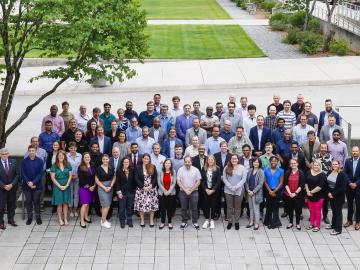
Filter News
Area of Research
- (-) Advanced Manufacturing (34)
- (-) Biology and Environment (177)
- (-) National Security (79)
- Biological Systems (18)
- Biology and Soft Matter (5)
- Building Technologies (12)
- Chemical and Engineering Materials (4)
- Chemistry and Physics at Interfaces (11)
- Clean Energy (522)
- Climate and Environmental Systems (14)
- Computational Biology (6)
- Computational Chemistry (5)
- Computational Engineering (5)
- Computer Science (19)
- Data (1)
- Earth Sciences (1)
- Electricity and Smart Grid (3)
- Energy Frontier Research Centers (14)
- Energy Sciences (5)
- Fossil Energy (3)
- Fuel Cycle Science and Technology (3)
- Functional Materials for Energy (16)
- Fusion and Fission (54)
- Fusion Energy (17)
- Geographic Information Science and Technology (3)
- Isotope Development and Production (3)
- Isotopes (35)
- Materials (433)
- Materials Characterization (2)
- Materials for Computing (36)
- Materials Synthesis from Atoms to Systems (13)
- Materials Under Extremes (12)
- Mathematics (1)
- Neutron Data Analysis and Visualization (4)
- Neutron Science (190)
- Nuclear Science and Technology (74)
- Nuclear Systems Modeling, Simulation and Validation (3)
- Nuclear Systems Technology (1)
- Quantum Condensed Matter (4)
- Quantum information Science (9)
- Reactor Technology (1)
- Renewable Energy (4)
- Sensors and Controls (5)
- Supercomputing (311)
- Transportation Systems (11)
News Topics
- 3-D Printing/Advanced Manufacturing (35)
- Advanced Reactors (3)
- Artificial Intelligence (22)
- Big Data (15)
- Bioenergy (47)
- Biology (74)
- Biomedical (17)
- Biotechnology (13)
- Buildings (3)
- Chemical Sciences (12)
- Clean Water (11)
- Climate Change (43)
- Composites (8)
- Computer Science (37)
- Coronavirus (15)
- Critical Materials (1)
- Cybersecurity (20)
- Decarbonization (20)
- Energy Storage (8)
- Environment (91)
- Exascale Computing (5)
- Frontier (4)
- Fusion (3)
- Grid (9)
- High-Performance Computing (24)
- Hydropower (8)
- Isotopes (2)
- Machine Learning (20)
- Materials (18)
- Materials Science (14)
- Mathematics (3)
- Mercury (7)
- Microscopy (10)
- Molten Salt (1)
- Nanotechnology (8)
- National Security (35)
- Net Zero (2)
- Neutron Science (9)
- Nuclear Energy (8)
- Partnerships (8)
- Physics (3)
- Polymers (2)
- Quantum Science (1)
- Renewable Energy (1)
- Security (12)
- Simulation (14)
- Space Exploration (1)
- Summit (12)
- Sustainable Energy (36)
- Transformational Challenge Reactor (2)
- Transportation (5)
Media Contacts

Cody Lloyd became a nuclear engineer because of his interest in the Manhattan Project, the United States’ mission to advance nuclear science to end World War II. As a research associate in nuclear forensics at ORNL, Lloyd now teaches computers to interpret data from imagery of nuclear weapons tests from the 1950s and early 1960s, bringing his childhood fascination into his career

In the search for ways to fight methylmercury in global waterways, scientists at Oak Ridge National Laboratory discovered that some forms of phytoplankton are good at degrading the potent neurotoxin.

Mirko Musa spent his childhood zigzagging his bike along the Po River. The Po, Italy’s longest river, cuts through a lush valley of grain and vegetable fields, which look like a green and gold ocean spreading out from the river’s banks.

ORNL, the Department of Energy’s largest multidisciplinary laboratory, and Fairbanks Morse Defense, a portfolio company of Arcline Investment Management, have entered into a Memorandum of Understanding to collaborate on the development and integration of alternative fuel technologies aimed at reducing the marine engine’s reliance on fossil fuels.

Since its inception in 2010, the program bolsters national scientific discovery by supporting early career researchers in fields pertaining to the Office of Science.

After completing a bachelor’s degree in biology, Toya Beiswenger didn’t intend to go into forensics. But almost two decades later, the nuclear security scientist at ORNL has found a way to appreciate the art of nuclear forensics.

Wildfires are an ancient force shaping the environment, but they have grown in frequency, range and intensity in response to a changing climate. At ORNL, scientists are working on several fronts to better understand and predict these events and what they mean for the carbon cycle and biodiversity.

Wildfires have shaped the environment for millennia, but they are increasing in frequency, range and intensity in response to a hotter climate. The phenomenon is being incorporated into high-resolution simulations of the Earth’s climate by scientists at the Department of Energy’s Oak Ridge National Laboratory, with a mission to better understand and predict environmental change.

When geoinformatics engineering researchers at the Department of Energy’s Oak Ridge National Laboratory wanted to better understand changes in land areas and points of interest around the world, they turned to the locals — their data, at least.

Experts across varied technology fields gathered ORNL to collaborate on the future of geospatial systems at the Trillion-Pixel GeoAI Challenge workshop. The third iteration of this event focused on multimodal advances in the field, including progress in artificial intelligence, cloud infrastructure, high-performance computing and remote sensing. These capabilities, when combined, can help solve problems in national and human security such as disaster response and land-use planning.


